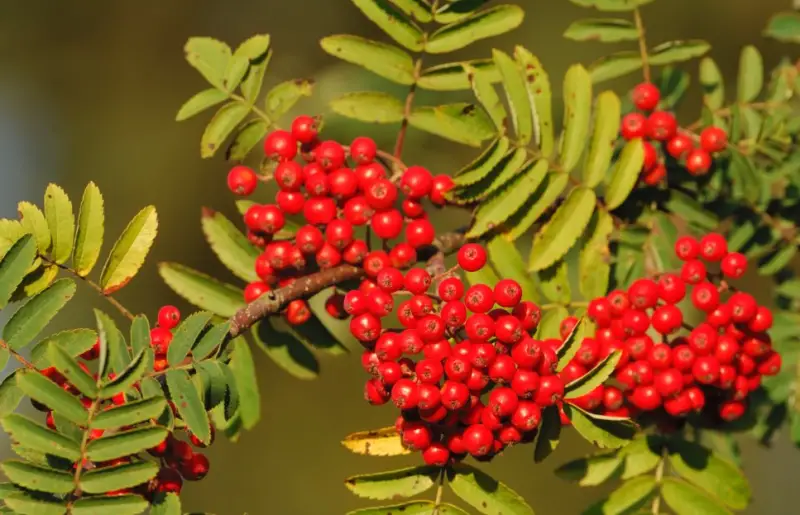Rowan trees, also known as mountain ash (Sorbus aucuparia), are deciduous trees renowned for their elegant appearance, vibrant berries, and ornamental foliage. These trees are popular in gardens and landscapes for their aesthetic appeal and resilience.
In this guide, we will explore everything you need to know about growing and caring for rowan trees.
Introduction to Rowan Trees

Rowan trees (Sorbus spp.) belong to the Rosaceae family and are native to temperate regions of Europe, Asia, and North America. These medium-sized trees are well-known for their adaptability to various soil conditions and their resilience to harsh weather. Rowan trees are particularly valued for their clusters of bright red or orange berries, which attract birds and wildlife, making them an excellent addition to gardens and natural landscapes.
Key Characteristics of Rowan Trees
- Scientific Name: Sorbus spp.
- Family: Rosaceae
- Common Names: Mountain ash, quickbeam
- Native Regions: Europe, Asia, North America
- Growth Habit: Deciduous tree with a rounded canopy
- Height: Typically grows between 20 to 40 feet (6 to 12 meters)
- Spread: 15 to 25 feet (4.5 to 7.5 meters)
- Lifespan: 50 to 100 years
- Foliage: Pinnately compound leaves with serrated edges, turning brilliant shades of yellow, orange, or red in autumn
- Flowers: Small, white, or creamy flowers in dense clusters (late spring to early summer)
- Fruits: Small, bright red, orange, or yellow berries that persist into winter
USDA Hardiness Zones
Rowan trees are hardy and can thrive in USDA Hardiness Zones 3 to 7, making them well-suited for cooler climates. They can withstand frost and moderate drought conditions once established.
Growth Rate
The growth rate of Rowan trees is generally moderate, with an annual increase of:
- 12 to 24 inches (30 to 60 cm) per year under optimal conditions.
- Slower growth in poor or dry soils, but still adaptable.
Growing Conditions
- Soil Type: Prefers well-draining, slightly acidic to neutral soil (pH 5.5–7.5)
- Sunlight: Thrives in full sun to partial shade
- Water Needs: Moderate; drought-tolerant once established
- Pruning: Minimal pruning required; remove dead or weak branches as needed
- Pest & Disease Resistance: Generally resistant to pests but susceptible to fire blight, powdery mildew, and aphids in some conditions
Benefits of Growing Rowan Trees
- Wildlife Attraction: Berries provide an essential food source for birds, especially in winter.
- Aesthetic Value: Beautiful foliage, flowers, and fruits make it an attractive ornamental tree.
- Ecological Benefits: Helps support biodiversity by providing habitat and food for various species.
- Traditional & Medicinal Uses: Historically used in folk medicine and woodcraft.
Choosing the Right Rowan Tree Variety
Rowan trees come in various species, each offering unique characteristics in terms of appearance, hardiness, and ornamental value. Below are some of the most popular varieties:
Common Rowan (Sorbus aucuparia)
This is the most widely recognized species, known for its bright red berries and pinnate leaves. It thrives in temperate climates and is highly valued for its resilience and ability to attract wildlife.
Swedish Whitebeam (Sorbus intermedia)
A hybrid species with distinctive silvery-green foliage and striking orange berries. This variety is well-suited to urban environments due to its high tolerance for pollution and compact growth habit.
Joseph Rock Rowan (Sorbus ‘Joseph Rock’)
This variety stands out with its eye-catching yellow berries and vibrant autumn foliage, turning shades of deep orange and red. It is an excellent choice for adding seasonal interest to gardens and landscapes.
Chinese Rowan (Sorbus hupehensis)
Characterized by its unique pinkish-white berries and bluish-green leaves, the Chinese rowan offers a delicate and ornamental appearance. It is a less common variety but highly prized for its aesthetic appeal.
Ideal Growing Conditions for Rowan Trees
To ensure the healthy growth of your rowan tree, it’s essential to provide the right environmental conditions, including suitable soil, adequate sunlight, proper watering, and appropriate planting location.
Soil Requirements
Rowan trees thrive in well-drained, fertile soil with a neutral to slightly acidic pH, typically ranging between 5.5 and 7.0. While they can tolerate poor or rocky soils, they perform best in loamy, nutrient-rich conditions that allow for proper aeration. To improve soil quality, incorporate organic matter such as compost or well-rotted manure, which enhances soil structure and nutrient availability. Additionally, ensuring good drainage is crucial, as stagnant water can lead to root rot and other fungal diseases.
Sunlight and Temperature
Rowan trees prefer full sun to partial shade, requiring at least six hours of direct sunlight per day for optimal growth, flowering, and fruiting. They are highly adaptable to different climates and are well-suited to temperate and cool regions. Their ability to withstand harsh winters makes them an excellent choice for areas prone to frost and snowfall. However, in very hot climates, providing some afternoon shade can help protect the tree from excessive heat stress.
Watering Needs
Once established, rowan trees exhibit good drought tolerance, making them relatively low-maintenance. However, young trees require regular watering to support root development, especially during dry spells. Deep watering once a week is generally sufficient, but the frequency may need to be adjusted based on soil type and weather conditions. Avoid overwatering, as prolonged moisture retention can lead to fungal infections and weakened root systems. Applying a layer of mulch around the base helps retain soil moisture while preventing weed growth.
Spacing and Planting Location
When planting rowan trees, adequate spacing is essential to ensure proper air circulation and prevent overcrowding. A minimum distance of 4-6 meters (13-20 feet) between trees allows for healthy canopy expansion and reduces the risk of disease transmission. Rowan trees are versatile and can be planted in various locations, including gardens, parks, and along streets as ornamental trees. Their attractive foliage, spring blossoms, and bright autumn berries make them a popular choice for landscape design.
How to Plant a Rowan Tree
Planting a rowan tree correctly is essential for its long-term health and growth. By following the right steps, you can ensure the tree establishes well and thrives in its new environment.
Selecting a Healthy Sapling
Choose a young rowan tree from a reputable nursery, ensuring it has a strong, well-developed root system and no visible signs of disease or pest infestations. Look for a sapling with a straight trunk, healthy branches, and vibrant leaves. Avoid trees with damaged roots, weak stems, or discolored foliage, as these may struggle to establish after planting.
Preparing the Planting Site
Select a location that receives full sun to partial shade and has well-drained, fertile soil. Rowan trees prefer loamy soil with a neutral to slightly acidic pH. Before planting, clear the area of weeds, grass, and debris to minimize competition for nutrients. Dig a hole that is at least twice as wide and as deep as the sapling’s root ball to allow ample space for root expansion. Loosen the soil at the bottom of the hole and mix in compost or well-rotted manure to enrich the soil and improve drainage. If the soil is heavy or clay-based, consider adding sand or grit to enhance aeration and prevent waterlogging.
Planting Process
Carefully remove the sapling from its container, taking care not to damage the roots. If the roots are tightly bound, gently tease them apart to encourage outward growth. Position the sapling in the hole, ensuring the root collar (the point where the roots meet the trunk) is level with the ground surface. Backfill the hole with the excavated soil, pressing it down gently to eliminate air pockets. Avoid compacting the soil too tightly, as this can hinder root development. Once planted, water the tree thoroughly to help settle the soil and establish good root-to-soil contact.
Mulching
Apply a 5-10 cm (2-4 inch) layer of organic mulch, such as bark chips, compost, or leaf litter, around the base of the tree. This helps retain soil moisture, regulate temperature, and suppress weed growth. Leave a small gap around the trunk to prevent moisture buildup, which can lead to rot or fungal diseases. Mulching also provides essential nutrients as it decomposes, contributing to the overall health of the tree.
Caring for Your Rowan Tree
Proper care ensures that your rowan tree remains healthy, resilient, and visually appealing throughout its lifespan. Regular pruning, appropriate fertilization, and proactive pest and disease management are key aspects of maintaining a thriving tree.
Pruning and Maintenance
Rowan trees have a naturally graceful shape, so minimal pruning is needed. However, removing dead, damaged, or crossing branches in late winter or early spring helps maintain the tree’s structure and health. Use clean, sharp pruning shears to make precise cuts and prevent unnecessary stress on the tree. Avoid heavy pruning, as excessive removal of branches can weaken the tree and reduce flowering and fruiting potential. Additionally, keep an eye out for suckers—small shoots that emerge from the base of the tree—and remove them promptly to direct the tree’s energy toward healthy growth.
Fertilization
While rowan trees do not require frequent fertilization, applying a balanced, slow-release fertilizer in early spring can enhance growth, particularly in nutrient-poor soils. A fertilizer with equal parts nitrogen, phosphorus, and potassium (such as 10-10-10) is ideal for promoting overall health. Alternatively, organic compost or well-rotted manure can be worked into the soil around the tree’s base to improve fertility and provide a steady source of nutrients. Avoid excessive fertilization, as too much nitrogen can encourage leafy growth at the expense of flowers and berries.
Pest and Disease Management
Rowan trees are generally hardy but may occasionally face pest and disease issues.
- Aphids: These small sap-sucking insects can cause curled or yellowing leaves. To control infestations, spray the tree with insecticidal soap or encourage natural predators like ladybugs to help keep aphid populations in check.
- Fire Blight: This bacterial disease causes wilting, blackened leaves, and branch dieback. Prune affected areas immediately, making cuts well below infected tissue, and disinfect pruning tools between cuts to prevent further spread.
- Powdery Mildew: This fungal infection appears as a white, powdery coating on leaves. To prevent mildew, ensure good air circulation by avoiding dense plantings and pruning selectively. Water at the base of the tree rather than overhead to keep foliage dry and reduce fungal growth.
Propagation of Rowan Trees
Rowan trees can be propagated through seeds or cuttings, allowing for both natural regeneration and controlled cultivation. Each method has its advantages, depending on the grower’s preference and available resources.
Growing from Seeds
Propagation by seed is a natural and cost-effective way to grow rowan trees, but it requires patience since germination can take several months. To begin, collect seeds from ripe berries in autumn. Gently mash the berries and rinse them in water to remove the surrounding pulp, which contains germination inhibitors. Once cleaned, the seeds need to undergo stratification—a process that mimics natural winter conditions to break dormancy. To do this, place the seeds in a container with moist sand or peat moss and store them in a refrigerator at temperatures between 1-5°C (34-41°F) for at least 6-8 weeks. This cold treatment enhances germination rates.
After stratification, sow the seeds in well-prepared, loose soil, either in pots or directly in a nursery bed. Keep the soil consistently moist but not waterlogged. Germination can take several months, and young seedlings require protection from harsh weather and pests. Once they develop strong roots and a few sets of leaves, they can be transplanted to their permanent location.
Propagation from Cuttings
Cuttings provide a faster way to propagate rowan trees, ensuring that the new plants retain the exact characteristics of the parent tree. The best time to take semi-hardwood cuttings is in late summer when the current season’s growth has partially matured but is still flexible. Select healthy, disease-free stems that are about 15-20 cm (6-8 inches) long. Remove the lower leaves, leaving only a few at the top to reduce moisture loss.
To encourage rooting, dip the cut end of the cutting in a rooting hormone before planting it in well-draining soil, such as a mix of sand and peat. Keep the cuttings in a warm, humid environment, ideally in a greenhouse or under a plastic cover to maintain high humidity. Regular misting helps prevent dehydration. Roots typically develop within a few weeks to a few months. Once the cuttings have established strong roots, they can be gradually acclimated to outdoor conditions before being planted in their final location.
Common Problems and Troubleshooting
Like any tree, rowan trees may encounter certain issues that affect their health, growth, and fruit production. Identifying and addressing these problems early can help maintain a strong and thriving tree.
Leaf Spot and Fungal Issues
Leaf spot diseases, often caused by fungal pathogens, manifest as small, dark spots on leaves that may eventually lead to yellowing and premature leaf drop. High humidity, poor air circulation, and excessive moisture contribute to fungal growth. To manage this issue, remove and dispose of affected leaves to prevent the spread of infection. Ensuring proper spacing between trees allows for better airflow, reducing humidity around the foliage. If the infection persists, applying a fungicide containing copper or sulfur can help control fungal spread. Additionally, watering at the base of the tree rather than overhead minimizes leaf moisture, further preventing fungal development.
Poor Berry Production
Rowan trees produce clusters of bright berries, but sometimes fruiting may be sparse or absent. One of the primary causes is insufficient sunlight. These trees require at least six hours of direct sunlight per day to produce abundant flowers and fruit. If the tree is planted in a shaded area, consider pruning surrounding vegetation to increase light exposure. Over-pruning can also be a factor, as excessive removal of branches may eliminate flower buds that eventually develop into berries. When pruning, maintain the tree’s natural structure and avoid cutting too many fruit-bearing stems. Additionally, a lack of pollination can affect berry production. If pollinators are scarce, planting other flowering plants nearby can attract bees and other beneficial insects to aid in pollination.
Weak Growth
If a rowan tree exhibits slow or weak growth, nutrient deficiencies or poor soil conditions may be the cause. Conducting a soil test can help determine if essential nutrients, such as nitrogen, phosphorus, or potassium, are lacking. Applying a balanced fertilizer in early spring supports healthy growth and development. Organic matter, such as compost or well-rotted manure, can also be added to enrich the soil. Compacted soil can restrict root expansion and limit nutrient absorption. If the soil around the tree appears compacted, aerating it by loosening the surface with a garden fork can improve root access to oxygen and water. Additionally, ensuring proper drainage prevents waterlogging, which can weaken the tree and stunt growth.
Conclusion
Rowan trees (mountain ash) are beautiful, hardy, and beneficial additions to any garden or landscape. With proper planting, care, and maintenance, these trees will provide stunning seasonal interest and support local wildlife for years to come. Whether grown for their ornamental appeal or their cultural significance, rowan trees are a fantastic choice for both novice and experienced gardeners alike.






